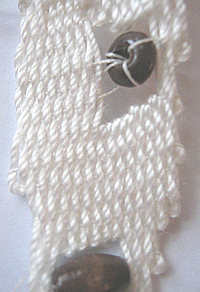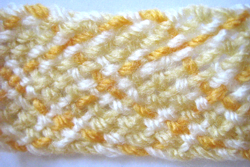Once a found an instruction on how to work an african necklace using needle weaving (also called ‘pin weaving’). It’s a weaving technique that allows to easily create strange shaped fabrics and to incorporate beads into.
Stunning!
I played around with this technique and thought that it could as well be used for little bags, for bracelets and so forth.
Unfortunately it’s a technique that requires a lot patience – which I don’t have. ;-)
I’d love to hear what you think about!
Tag: Weaving
Crazy Daisies
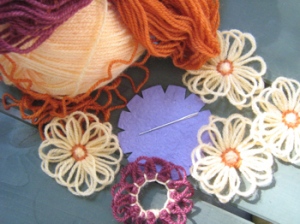
While searching for something else I found a lot of instructions and tips about Crazy Daisies and had to try them immediately ;-)
As you can see on the photo, my attempt on winding daisies on my own daisy loom worked out very well.
I cut the loom (the purple item on the photo) from thick cardboard. I think that the ice cream lid loom is better, because plastic won’t loose its shape so easily, but for just a couple flowers cardboard is fine.
At my first flowers I just made a very simple backstich center, but even so I find those little flowers stunning ;-)
The dark red flower is a daisy with an open center, but I made it in a different way: I didn’t wind the thread to the other side of my selfmade cardboard loom but to another notch (always the fourth notch in place of the sixth, I think. I didn’t write it down, because I don’t like it so much).
I’m planning to make something like the shrug with a lot of flowers and a simple crochet edging.
Eventually. ;-)
Links:
(all in English, but with explaining pictures and photos)
Instructions and tips about Crazy Daisies
For example:
Round ice cream lid daisy loom
Instructions on how to wind daisies
How to make a backstich center daisy
How to make a open center daisy
Simple crochet edging
Stole, Shrug, Handbag and Three Different Shapes on the Crazy Daisy Winder (from 1945)
Kumihimo

Once I took a class for Kumihimo braiding – that is a japanese technique for braiding cords.
I really enjoyed the class and the work with the marudai, but I can’t afford to buy one. And although I found a tutorial on how to make your own marudai I prefer now to work with a cardboard disk. I braided for hours during train journeys. I can’t do this with a marudai ;-)
I didn’t find many instructions on how to make kumihimo cords in internet (see those I found below), so I will present my own.
On the photo you see my cardboard marudai and a braid I’m working on. I changed the pattern several times to get a more interesting appearance.
What you need:
- 4 threads of yarn in 2 different colours (e.g. 2 red and 2 yellow) (test it e.g. with 100 cm/39 inches)
Note: in the beginning both threads should be of the same gauge. - cardboard marudai disk (not too thin cardboard)
Note: This is a cardboard disk with a hole in the middle and cuts around.
For the beginning,3612-16 cuts are sufficient, later you may need more depending on the number of threads and the pattern.
You can use the marudai picture as template to be cut from cardboard. - a little weight
Note: I use mostly some coins in a little plastic bag. - quite a lot of patience ;-))
(click or scroll to go to the instructions below)
What you do:
(Click on pictures to enlarge)
Fold the threads in half and knot all together at the fold.
You have now 8 threads, connected to each other at one side.
 Wedge the threads into the cuts as seen in pic. 1.
Wedge the threads into the cuts as seen in pic. 1.
The knot is in the middle.
Cling your little weight to the knot of the threads. It provides a certain tension on the threads.
 Braid: Move the threads as seen in the pics 2 and 3 to the desired length.
Braid: Move the threads as seen in the pics 2 and 3 to the desired length.
After four moves you must have a ‘real’ cross again, otherwise you made a mistake.
But don’t worry, after a little practise you will see which thread should be moved next.
With 100 cm/39 inches you’re using quite short threads, but they tend to entangle anyhow. Therefore you must pull them free at every round. When the treads become longer, see to it to use some (self-made) bobbins.
The finished braid is a lot shorter than the threads, but I don’t know no factor.
Have fun
(and check the links to find more patterns)


 I worked a lot of cords with different yarns in matching colours, included funky yarns and strands of beads and simply braided them together to get a big necklace:
I worked a lot of cords with different yarns in matching colours, included funky yarns and strands of beads and simply braided them together to get a big necklace:
 And then I worked several braids with sewing yarn in matching colours, included metallic threads. Every braid has another braiding pattern. They are supposed to be a necklace, but up until know I haven’t finished it yet.
And then I worked several braids with sewing yarn in matching colours, included metallic threads. Every braid has another braiding pattern. They are supposed to be a necklace, but up until know I haven’t finished it yet.
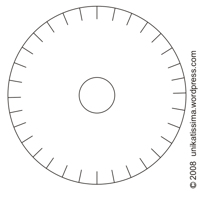 Cardboard marudai template (click picture to enlarge)
Cardboard marudai template (click picture to enlarge)
Links:
Wikipedia: English entry for ‘Marudai’
Wikipedia: English entry for ‘Kumihimo’ – German entry for ‘Kumihimo’
Self-made Marudai and bobbins:
Tutorial on how to make your own marudai
At Gabriela Marková’s Kumihimo blog:
Check the entries labelled with ‘Equipment’
Kumihimo braids:
Check Gabriela Marková’s Kumihimo blog
An instruction for a Kumihimo braid with 12 threads (with diagrams)
An instruction for a Kumihimo braid with 8 threads (German) (PDF-file) (with diagrams)
An instruction for a Kumihimo braid with 16 threads (German) (PDF-file) (with diagrams)
Diagrams for Kumihimo software, can be used as pattern (with diagrams)
See also how different your braid looks when changing the order of the threads or of moves (with diagrams)
An interesting pattern (with diagrams)
A pattern with 16 threads (with diagrams)
An instruction similar to mine (English) (PDF-file) (with diagrams)
An instruction for a Kumihimo braid with 12 threads (English) (with diagrams)
An instruction for a Kumihimo braid with 16 threads (English) (with diagrams)
An instruction for a Kumihimo braid with 8 threads (English) (with diagrams)
Linklists about Kumihimo:
Squidoo
Shelly Gillmann’s Kumihimo Links
Bead and Wire Wall Vase

Inspired by two wonderful items, the Bead & Wire Heart at The Bead Bugle and the Bead Godesses from Ronda Kivett at the Autumn 2003 Issue of ARTitude Zine I did deliberately my vase from the photo.
I feel that I was a little too cautious, but I like it already.
Next time I want to get nearer to those shining examples I had.
Links:
Bead & Wire Heart at The Bead Bugle
Bead Godesses from Ronda Kivett at the Autumn 2003 Issue of ARTitude Zine
Fingerloop Braiding
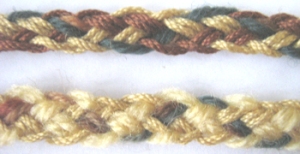
Sometimes you need some cord and one fun and fast way to make one is fingerloop braiding (for tutorials see Links below).
It is a medieval technique and I used it several times with good results.
On the photo you see two of my self-made cords.
The most difficult part is for me to get the cord evenly, because you must adapt to the loops become shorter while working.
But it is only a question of practising ;-)
Links:
Fingerloop.org:
Basic Braiding Instructions
Phiala’s String Page:
Basic Braiding Instructions
Fingerloop braiding for two or more people
The Tudor Costume Page:
Making Finger Braids (many explaining photos)
Hochmittelalter Infoseite:
Fingerloop Braiding (German, very good illustrations)
Braided Scarf
On the photo you see my try of the technique described in the tutorial on how to braid a scarf.
I used simple acrylic yarn and it looks as if I pulled more on one side then on the other, as you can see on the photo.
At a later moment I will try it again, because I like how it should look ;-)
Freeform Embroidery
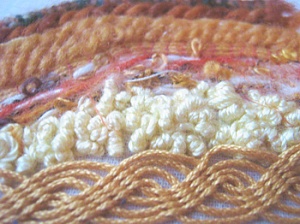
On the photo you see my idea of Freeform Embroidery which was highly inspired by ‘Rock Pool’ and ‘Laying It On The Line’.
I used a piece of old (but clean! ;-)) bedsheet as base. First I laid some worsted and funky yarns on it which I fixed with couching stitches (at the top of the photo). Then I stitched some french knots (light yellow on the photo). Below is my first attempt at ply-split braiding which I fixed with some couching stitches too.
It is one of my many UFOs (‘unfinished objects’), but one day I will come back to it ;-)
Links:
Inspirations: ‘Rock Pool’ / ‘Laying It On The Line’
English Embroidery Stitch Diagrams
Deutsche Stickstichbeschreibungen
Couching stitches (English)
Couching stitches (German)
French knots (English)
French knots (German)
Ply-split Braiding: a (very) short description and resources
PDF Ply-split tutorials by Peter Collingwood (scroll down)
Friendship Bracelet
I once braid a Friendship Bracelet, but in just one colour. The ones at Heather’s Friendship Bracelets are so beautiful because of the different colour patterns she presents.
I haven’t done them yet, but they are on my to-do list (together with a gazillion of other things to try ;-))
Links:
Heather’s Friendship Bracelets
Note: even though there’s written something about a move I could stilll reach the links
Friendship Bracelet – first pattern of first set
Cardboard Weaving Frame

Once I wanted to create a picture frame with a woven border. I simply made a cardboard loom with an opening where I wanted to put the picture.
 It worked out well, but I didn’t really like it when finished ;-)
It worked out well, but I didn’t really like it when finished ;-)
I wanted to share anyway.
The sketch shows how to wrap the yarn.
If you want to see it better, enlarge the picture by clicking on it.
If you want to know how to weave on a cardboard loom, see the Links below.
Links:
Tutorial on how to weave with a cardboard loom
Tutorial on how to weave with a cardboard loom
Cardboard Box Loom
I really wanted to try weaving, but I was not keen on buying a loom without knowing if I like weaving.
After some surfing I found All Fiber Arts, a website with so many instructions about – yeah, all fiber arts ;-))
I will get back there later again writing about another subject.
But for today: The instruction on how to build a loom using a cardboard box and how to weave on it was a great help.
I tried it with remains from my yarn stash and wove a little piece of fabric. This little piece of fabric stayed an UFO (unfinished object) since then, because I find weaving not so much fun then I expected it to be ;-))
And so I didn’t bother to take a photo.
At any rate I’m grateful to All Fiber Arts, because they prevented me from buying something expensive that I didn’t really need. :-)
Links:
All Fiber Arts: A website with information, instructions and much more about everything concerning fiber arts
Instruction on how to build a loom using a cardboard box and how to weave on it
